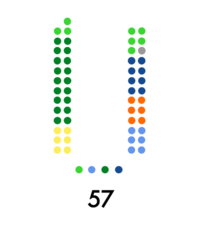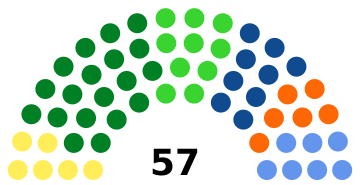Legislative Assembly of Costa Rica facts for kids
{{Infobox Parliament | background_color = #4169E1 | text_color = | name = Legislative Assembly | coa_pic = Asamblea Legislativa de Costa Rica (emblema).svg | coa_res = 200px | native_name = Asamblea Legislativa de la República de Costa Rica | session_room = Nuevo Plenario Legislativo.jpg | session_alt = Session room since 2020 | house_type = Unicameral | leader1_type = President | leader1 = Rodrigo Arias Sánchez | election1 = 1 May 2022 | party1 = PLN | leader2_type = Vice president | leader2 = Gloria Navas Montero | election2 = 1 May 2022 | party2 = PNR | leader3_type = First Secretary | leader3 = Melina Ajoy Palma | election3 = 1 May 2022 | party3 = PUSC | members = 57 | structure1 =  || political_groups1 = Government (9)
|| political_groups1 = Government (9)
- PPSD (9)
Opposition (48)
- PLN (19)
- PUSC (9)
- PNR (7)
- PLP]] (6)
- FA (6)
- Independents (1)
The Legislative Assembly (Spanish: Asamblea Legislativa) is like the main law-making group in Costa Rica. It's the only one of its kind (unicameral) and is part of the country's government. You can find its building in the capital city, San José.
This Assembly has 57 members, called deputies (Spanish: diputados). People vote for them directly in elections. They are chosen from lists provided by political parties in each province. Deputies serve for four years. A rule from 1949 says that a deputy cannot serve two terms in a row. However, they can run again after taking a break for one term.
Contents
Political Groups in the Assembly
In Costa Rica, political parties form groups in the Legislative Assembly. These groups are called "parliamentary fractions." Each fraction represents a political party that won seats in the election.
A deputy is part of the fraction of the party they were elected for. They can only belong to one fraction at a time. This rule helps keep things organized.
About the Deputies
Deputies are chosen to represent different provinces in Costa Rica. The Assembly always has 57 deputies. After a population count, the number of deputies for each province might change. This change makes sure each province has a fair number of representatives based on its population.
Who Can Be a Deputy?
To become a deputy, you need to meet a few simple rules:
- You must be a citizen of Costa Rica.
- You must be born in Costa Rica, or have lived there for at least ten years after becoming a citizen.
- You need to be at least 21 years old.
Who Cannot Be a Deputy?
Some people cannot be elected as deputies. This is to prevent conflicts of interest. For example:
- The President of Costa Rica or anyone acting as President during the election.
- Government Ministers.
- Judges of the Supreme Court of Justice.
- Military members who are actively serving.
- People who manage certain public institutions.
- Close relatives of the President.
These rules apply if someone holds these positions within six months before an election. Deputies also cannot take other jobs in the government or public institutions after they are sworn in. This helps them focus on their work in the Assembly.
Special Protection for Deputies
Deputies have a special protection called "parliamentary immunity." This means they cannot be held responsible for what they say during official Assembly meetings. It allows them to speak freely without fear of being sued or arrested for their opinions.
They also cannot be arrested for most reasons while the Assembly is meeting. If they are accused of a crime, the Assembly usually has to agree to remove their protection first. This protection helps them do their job without being unfairly stopped.
Independent Deputies
Sometimes, a deputy might leave the political party they were elected with. When this happens, they become an "independent deputy." They still keep their job as a deputy and all their rights.
However, an independent deputy cannot join another political group in the Assembly. They also cannot form their own new group or "bloc." This is because the rules say that only political parties can form official groups in the Assembly. Even though deputies have the freedom to leave a party, they must have been elected through a party to be in the Assembly.
How Deputies Are Chosen
The Legislative Assembly has 57 deputies. They are chosen from lists provided by political parties. Experts sometimes suggest increasing the number of deputies. This would allow more people to be represented. However, many people in Costa Rica don't like this idea.
For example, a report by the United Nations Development Programme suggested having 82 deputies. Another study from Northwestern University even recommended 115 deputies for Costa Rica, based on its population.
There are also ideas to change how deputies are elected. Currently, people vote for a party's list of candidates. Some proposals suggest a system where people vote directly for a specific deputy in their area. This would be similar to the system used in Germany.
Assembly Members by Province
This table shows how many deputies each province has in the Assembly for the 2018-2022 period:
| Province | Number of seats | Population (as of 2023 census) |
|---|---|---|
| 19 | 1,404,242 | |
| 11 | 848,146 | |
| 7 | 490,903 | |
| 6 | 433,677 | |
| 4 | 326,953 | |
| 5 | 410,929 | |
| 5 | 386,862 |
Assembly Leadership
After the 2022 election, Rodrigo Arias Sánchez became the President of the Legislative Assembly. He is from the National Liberation Party. Most other parties supported him, except for the Broad Front.
Political Groups in the Assembly (2022-2026)
This table shows the different political groups and how many seats they have in the Assembly from 2022 to 2026:
| Parliamentary fractions 2018-2022 | ||||||
|---|---|---|---|---|---|---|
| Fraction Name (English) | Fraction Name (Spanish) | Abbrev. | Seats | Percentage of Assembly | Party Flag | |
| National Liberation Party | Partido Liberación Nacional | PLN | 19 | 33.93% | ||
| Social Democratic Progress Party | Partido Progreso Social Democrático | PPSD | 10 | 17.86% | ||
| Social Christian Unity Party | Partido Unidad Social Cristiana | PUSC | 9 | 16.07% | ||
| New Republic Party | Partido Nueva República | PNR | 7 | 12.28% | ||
| Liberal Progressive Party | Partido Liberal Progresista | PLP | 6 | 10.71% | ||
| Broad Front | Frente Amplio | FA | 6 | 10.71% | ||
The Assembly Building
In October 2020, a brand new building for the Legislative Assembly was opened. It has eighteen floors and is also located in San José.
Before this, the Assembly met in the "Central Building." Work on that old building started in 1937. It was supposed to be a new presidential palace. But because many building materials came from Germany and Czechoslovakia, the start of World War II stopped the project. Work didn't restart until 1957, and the Assembly moved in by 1958.
History of the Assembly
The idea for Costa Rica's Legislative Assembly goes way back to earlier government groups. The modern Assembly was created after the Costa Rican Civil War in 1948. After the war, a group led by José Figueres Ferrer helped elect a special assembly. This assembly then wrote the Constitution of Costa Rica between 1948 and 1949. This Constitution set up the rules for how the Assembly works today.
Over the years, different political parties have held power in the Assembly. They form groups to work together and pass laws.
Central American Parliament
Costa Rica is the only Spanish-speaking country in Central America that does not send deputies to the Central American Parliament. This is a special parliament for countries in Central America.
See also
 In Spanish: Asamblea Legislativa de Costa Rica para niños
In Spanish: Asamblea Legislativa de Costa Rica para niños
- List of presidents of the Legislative Assembly of Costa Rica
- Politics of Costa Rica
- List of legislatures by country


